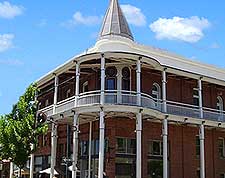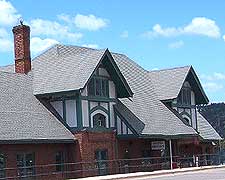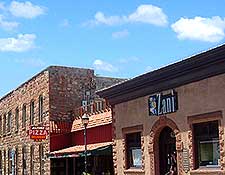Flagstaff History Facts and Timeline
(Flagstaff, Arizona - AZ, USA)

In 1855, a group of pioneers led by Lieutenant Edward Fitzgerald Beale camped in an area which is now occupied by the modern city of Flagstaff. The pioneers stripped a ponderosa pine tree and raised the American flag. As the settlement grew, it was easily recognized by travelers who noted its resident 'flagstaff', and this landmark eventually became accepted as its formal name.
Thomas F. McMillan established a more permanent settlement in 1976 and the city experienced steady, yet unremarkable, growth until the last decade of the 20th century.
The Lowell Observatory and Pluto's Discovery
In 1894, Flagstaff was identified as the perfect site for an astronomical observatory, due to its high elevation next to Mount Elden. Two years after the site was identified, astronomer Percival Lowell opened his new observatory, fitted with a 24-inch / 61-cm Clark telescope.
The year 1930 was one of the most significant years in the history of Flagstaff, when the planet Pluto was discovered using that very same telescope. Nowadays, tourists who visit the observatory can use the telescope themselves and enjoy guided tours of the premises.

History of the Railway Development
While the establishment of the Lowell Observatory meant that Flagstaff was recognized on the world stage, the arrival of the railway was much more important to the local economy. By the 1890s, up to 100 train services passed through the town each day, allowing farmers and loggers to access local markets.
The railway also marked the beginning of tourism in Flagstaff, with travelers resting here on their way to the
Grand Canyon. The Arizona Historical Society-Pioneer Museum on the North Fort Valley Road displays a number of artifacts dating back to these times.
Increased affluence allowed local families to build a better class of home. One good example of this is the Arts and Crafts style home in the Riordan Mansion State Historic Park. This particular family house dates back to 1904 and remains impressive.

The Roaring 1920s
From 1926, the numbers of tourists heading to the Grand Canyon increased after the completion of Route 66. In 1928, Flagstaff was incorporated as a city and a year later, the first motel was opened. The Motel Du Beau provided rooms for the travelers who plied Route 66.
The Apollo Program
During the 1960s, the Apollo program meant that the Lowell Observatory was at the forefront of astronomical research in the USA. The Clark telescope was used to map the lunar landing sites, while two asteroids were named after the city and the Flagstaff Symphony Orchestra, respectively. The orchestra dates back to 1899 and continues to perform on the Northern Arizona University campus.
Flagstaff in the Present Day
The city began to decline somewhat during the 1960s and '70s, when many businesses moved out of the center to purpose-built developments. However, a 1980s regeneration program led to the construction of a new city hall, courthouse and library.
In the following decade, the city's pavements were decorated with distinctive brick paving, while shops and restaurants moved into some of the older city-center buildings, reminding visitors of earlier times in the history of Flagstaff. To this day, the historic center appeals to a wide range of tourists.
 In 1855, a group of pioneers led by Lieutenant Edward Fitzgerald Beale camped in an area which is now occupied by the modern city of Flagstaff. The pioneers stripped a ponderosa pine tree and raised the American flag. As the settlement grew, it was easily recognized by travelers who noted its resident 'flagstaff', and this landmark eventually became accepted as its formal name.
In 1855, a group of pioneers led by Lieutenant Edward Fitzgerald Beale camped in an area which is now occupied by the modern city of Flagstaff. The pioneers stripped a ponderosa pine tree and raised the American flag. As the settlement grew, it was easily recognized by travelers who noted its resident 'flagstaff', and this landmark eventually became accepted as its formal name.
